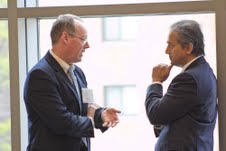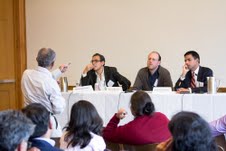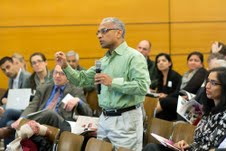Contribute
| Harvard SAI Symposium Focus On Heatlh In South Asia |
Press Release
05/07/2012
On
April 26th and 27th, South Asia Initiative at Harvard
University held its second annual symposium, focusing on Health in South
Asia: Lessons for and from the World. The conference brought together
global experts with deep research, implementation and policy experience to
learn and find new modes for global exchange. Harvard Provost Alan
Garber noted that care with comparable outcomes is being delivered in India
at a fraction of American providers’ models, as a result of the relentless
focus on efficiency that results in tough constraints. Indeed, Sri Lanka,
Tamil Nadu and Kerala have achieved health outcomes comparable to advanced
economies for a fraction of the health spending, with Bangladesh and Nepal
rapidly improving. While
resource scarcity and urgent needs have created opportunities for
experimentation and innovation, former Secretary of Health and Family Welfare
of India, Sujatha Rao,
urged the audience to think bilaterally. South Asian countries, with
increasingly complex systems dominated by the private sector, could benefit
from increased incorporation of evidence-based policy development—such as those
pioneered by Mexico—and good governance and enforced regulation. Alan
Garber spoke of the resources that Harvard and others are investing in medical
training in India to build capacity for leadership in areas of cutting-edge
research and development. Arthur
Kleinman spoke of exciting potential in China to tackle mental health, a
leading yet highly marginalized cause of disability globally. History
offers examples of groundbreaking approaches that have moved from China to
South Asia—India’s cadre of a staggering 800,000 community health activists
(ASHA) tasked with bringing neonatal care to the doorsteps of rural households,
has its roots in China’s “barefoot doctors†model. Joined by Sarah Pinto from Tufts University, and Neil Aggarwal from Columbia, the panel
discussed family planning successes in Bangladesh and how the recent decreases
in maternal mortality draw on the same principle that continuous community
presence is essential. These delivery models also acknowledge the role of
non-medical factors and practices. Clean water and food are huge areas of
vulnerability, particularly with increasing populations and hyper-dense
slums. Social networks and family ties are also influenced by the changing
contexts; new inequities, at the micro and macro levels are emerging. Day
1 focused on understanding the issue, to create a platform for Day 2’s
discussion on the solutions. Speakers included Devi Shetty,
founder of one of the India’s largest specialty healthcare providers, and Julio
Frenk, Dean of the HSPH and former Minister of Health, Mexico. Dr.
Devi Shetty kicked off Day 2 by an inspiring idea: within a few years, we will
see heart surgeries available for $800. In a world where currently heart
surgery, first pioneered over a century ago, remains affordable to only about
10% of the population, this is hugely exciting. Already his 14 hospitals
in India serve thousands annually with high quality, low-cost tertiary
services. His visions are much greater—already Narayana Hrudayalaya
Institute of Medical Sciences is involved in establishing a medical education
program in the Cayman Islands and advocating for fundamental shifts in how
medicine is taught and practiced. Manpower, not money, he said, was the
greatest limitation facing health care delivery today. Innovation
can mitigate the challenges, as demonstrated by the panel on New Technologies,
which brought together Anita Goel,
CEO of NANOBIOSYM, Glenn Cohen,
Assistant Professor at Harvard Law School, Ramesh
Raskar, Associate Professor at MIT and co-founder of EyeNetra.com, and Conor Walsh Assistant Professor of
Mechanical and Biomedical Engineering at Harvard School of Engineering and
Applied Sciences. Raskar highlighted his low cost technology to accurately
diagnose nearsightedness, farsightedness, and astigmatism on a mobile phone,
providing an easy convenience for the 2.4 billion people worldwide who don’t
have glasses due to lack of access to eye care. Goel discussed the innovations
developed by NANOBIOSYM, which brings together fundamental physics,
biomedicine, nanotechnology, and information science across traditional
boundaries to create transformational impacts to some of the problems of today.
In discussing these innovations, the panel also highlighted the ethical
obligations of those creating these new technologies. Walsh believes that in
order for these innovations to effectively alleviate challenges, developers
need to integrate into medical contexts and processes so that they observe
“what if†moments to translate into needed solutions. Under Walsh’s
supervision, interdisciplinary student teams from Harvard will spend time at
medical institutions this summer, including Shetty’s Narayana Hrudayalaya. On
what may be considered the dark side to new technologies, Cohen discussed the
ethical landscape of medical tourism and the different kinds of medical tourism
that exist. Cohen highlighted the kidney tourism trade in Bangladesh, Pakistan,
and India. In Pakistan for example, over 2,000 kidneys have been sold as a
result of kidney tourism, with 2/3 of the kidneys being received by foreigners. In
his keynote, Dr. Paul Farmer reflected
on experiences from Rwanda and Haiti, two countries that in recent years have
been forced to rebuild their health systems, to illustrate what effective
design could look like, and what it accomplishes. Fundamentally, the role of
the fixed health facilities has evolved: most people don’t need hospital-based
services on a regular basis. Health systems should recognize and address
the social dimensions of health, such as poverty and gender equity, and include
a strong community component. A
panel on Relative Roles of Markets and Government, brought economist Amitabh Chandra, Professor of Public
Policy at Harvard Kennedy School, Michael
Kremer, Gates Professor of Developing Societies, also at Harvard Kennedy
School, and Abhijit Banerjee, of MIT
and the founder of the Abdul Latif Jameel Poverty Action Lab. This conversation
focused on the economics of healthcare and ways to address the challenges. Dr. Julio Frenk expanded on the
solutions during his closing remarks. A key piece of needed health care
reform is innovation in delivery of care. Increasingly, experts and
policy makers in the United States are looking to the Global South for
guidance, given their ongoing experimentation with “frugal†solutions, from
complex issues like eye surgery at Aravind Eye Hospital to basic preventive
care delivered at the doorstep. Frenk
also emphasized that a key strategy for effective health systems is
collaboration. Often conversations are framed as “public vs. private,†when in
reality these are complementary players. Similarly, collaborations
between South and North institutions can be quite fruitful. Many of the
successes shared at the conference were the result of team with diverse
expertise and experience that were able to bring global knowledge to bear on a
local set of challenges. “We
were thrilled that many faculty and students with limited exposure to the
region joined to learn; their astonishment at the diversity and sophistication
of activities was palpable. The willingness of leaders from South Asia like
Devi Shetty and Sujatha Rao to participate in the event, made it truly
exciting. It’s clear that South Asia is a bastion of innovation in health
care; how we harness the learning to utilize it globally is a formidable but
energizing challengeâ€, noted Tarun
Khanna, SAI Faculty Director and Jorge Paulo Lemann Professor at the
Harvard Business School.
You may also access this article through our web-site http://www.lokvani.com/


